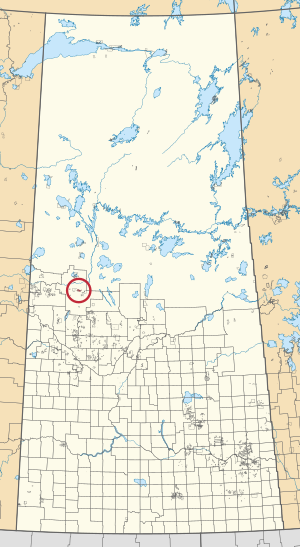Flying Dust 105D facts for kids
Quick facts for kids
Flying Dust 105D
|
|
|---|---|
| Flying Dust Indian Reserve No. 105D | |

Location in Saskatchewan
|
|
| First Nation | Flying Dust |
| Country | Canada |
| Province | Saskatchewan |
| Area | |
| • Total | 2,477.1 ha (6,121.0 acre) |
Flying Dust 105D is a special area of land in Saskatchewan, Canada. It is known as an Indian reserve, which is land set aside for the use and benefit of a First Nation community. This particular reserve belongs to the Flying Dust First Nation.
Contents
What is a First Nation?
In Canada, "First Nation" is a term used to describe many of the Indigenous peoples. These communities have their own unique cultures, languages, and histories. They are the original inhabitants of the land that is now Canada.
Understanding Indian Reserves
An Indian reserve is a piece of land that the Canadian government holds for the use of a First Nation. These lands are meant to provide a home and a place for First Nation communities to live and practice their traditions. Reserves are important for preserving the culture and heritage of these groups.
Purpose of Reserves
Reserves allow First Nations to have a designated territory. This helps them maintain their unique way of life. It also provides a place for their members to live together as a community.
Flying Dust First Nation
Flying Dust 105D is one of the reserves belonging to the Flying Dust First Nation. This First Nation is a self-governing community. They work to manage their own affairs and provide services for their members.
Location and Size
Flying Dust 105D is located in the province of Saskatchewan. It is part of what is known as Division No. 17. The reserve covers an area of 2477.1 hectares. This is about 24.77 square kilometers.
Importance of the Land
The land is very important to the Flying Dust First Nation. It is where their community is based. It provides space for homes, community buildings, and traditional activities.
Governing the Community
Like other First Nations, the Flying Dust First Nation has its own leadership. They have a chief and council who are elected by the community members. These leaders make decisions for the well-being of their people.
Community Life
Life on a reserve often involves a mix of traditional and modern ways. People work, go to school, and participate in community events. Many First Nations work to keep their languages and cultural practices strong.
Future of First Nations
First Nations like Flying Dust are working towards a stronger future. They aim for self-determination and economic growth. This helps their communities thrive for generations to come.

